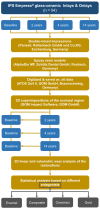In Vivo Wear Analysis of Leucite-Reinforced Ceramic Inlays/Onlays After 14 Years
- PMID: 40805325
- PMCID: PMC12347852
- DOI: 10.3390/ma18153446
In Vivo Wear Analysis of Leucite-Reinforced Ceramic Inlays/Onlays After 14 Years
Abstract
Material wear significantly impacts the clinical success and longevity of dental ceramic restorations. This in vivo study aimed to assess the wear behavior of IPS Empress® glass-ceramic inlays and onlays over 14 years, considering the influence of different antagonist materials. Fifty-four indirect restorations of 21 patients were available for comprehensive wear analysis, with complete follow-up data for up to 14 years. Three-dimensional measurements relied on digitized epoxy resin models produced immediately post-insertion (baseline) and subsequently at 2, 4, and 14 years. The occlusal region on the baseline model was delineated for comparative analysis. Three-dimensional superimpositions with models from subsequent time points were executed to assess wear in terms of average linear wear and volumetric loss. Statistical analyses were conducted in R (version 4.4.1), employing Mann-Whitney U tests (material comparisons) and Wilcoxon signed rank tests (time point comparisons), with a significance threshold of p ≤ 0.05. During the entire study period, an increase in wear was observed at each assessment interval, gradually stabilizing over time. Significant differences in substance loss were found between the follow-up time points, both for mean (-0.536 ± 0.249 mm after 14a) and integrated distance (-18,935 ± 11,711 mm3 after 14a). In addition, significantly higher wear was observed after 14 years with gold as antagonist compared to other materials (p ≤ 0.03). The wear behavior of IPS Empress® ceramics demonstrates clinically acceptable long-term outcomes, with abrasion characteristics exhibiting stabilization over time.
Keywords: all-ceramic restorations; ceramic inlays/onlays; long-term clinical investigation; occlusal interactions; wear behavior; wear of glass-ceramic.
Conflict of interest statement
The authors declare that this study received funding from 3M Espe (Seefeld, Germany). The funder was not involved in the study design, collection, analysis, interpretation of data, the writing of this article or the decision to submit it for publication.
Figures




Similar articles
-
Wear of ceramic and antagonist--a systematic evaluation of influencing factors in vitro.Dent Mater. 2008 Apr;24(4):433-49. doi: 10.1016/j.dental.2007.06.016. Epub 2007 Aug 27. Dent Mater. 2008. PMID: 17720238
-
[Fitness of onlays fabricated with direct and indirect CAD/CAM technology in vitro].Beijing Da Xue Xue Bao Yi Xue Ban. 2025 Jun 18;57(3):604-609. doi: 10.19723/j.issn.1671-167X.2025.03.027. Beijing Da Xue Xue Bao Yi Xue Ban. 2025. PMID: 40509841 Free PMC article. Chinese.
-
Metal-free materials for fixed prosthodontic restorations.Cochrane Database Syst Rev. 2017 Dec 20;12(12):CD009606. doi: 10.1002/14651858.CD009606.pub2. Cochrane Database Syst Rev. 2017. PMID: 29261853 Free PMC article.
-
Ceramic inlays for restoring posterior teeth.Cochrane Database Syst Rev. 2003;(1):CD003450. doi: 10.1002/14651858.CD003450. Cochrane Database Syst Rev. 2003. Update in: Cochrane Database Syst Rev. 2015 Sep 29;(9):CD003450. doi: 10.1002/14651858.CD003450.pub2. PMID: 12535474 Updated.
-
Long-term performance of ceramic in/-onlays vs. cast gold partial crowns - a retrospective clinical study.Clin Oral Investig. 2024 May 3;28(5):298. doi: 10.1007/s00784-024-05682-7. Clin Oral Investig. 2024. PMID: 38702521 Free PMC article.
References
-
- Forna N.C., Uleanu R., Lungu I., Dimofte A.-R. Dental ceramics: Advantages and benefits. Practice. 2024;4:7.
LinkOut - more resources
Full Text Sources

